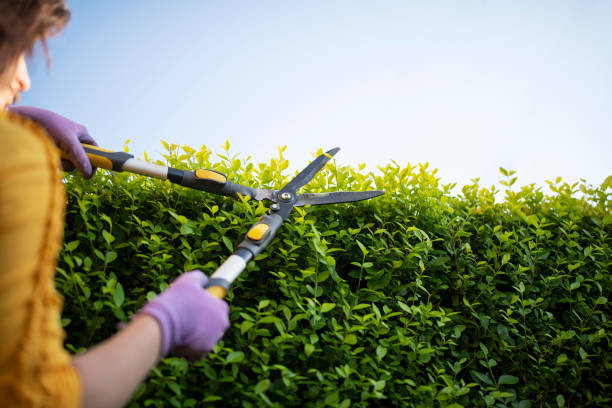Hedge trimming is a major chore, especially when the hedges are tall and dense. Hedge pruning can seem like a daunting task, but it’s quite simple once you know a few strategies. In this article, we’ll look at some novel approaches to simplifying the task of trimming hedges.
Everything you need to know to have a more positive hedge trimming experience will be covered, from picking the correct tools to picking the optimum time to trim. Put on your gardening gloves and we’ll get to work!
Hedge Trimming What Is It?
Hedge trimming, also known as shrub or bush maintenance, entails reducing the size and shape of the plant’s foliage through selective pruning and shaping. Trimming a hedge should be done to produce a uniform and orderly hedge that improves the look of the surrounding landscape.

Hedge trimming is accomplished by carefully cutting the hedge’s foliage to the proper form and size with specialized instruments like hedge trimmers or shears. Some hedges need to be trimmed every few weeks, while others may only need it once or twice a year. This varies greatly based on the hedge’s growth rate.
When a hedge is trimmed, dead or diseased branches are removed, and the plant is given more room to breathe and more exposure to sunshine, all of which contribute to its overall health and growth. Hedgerows that are kept in good shape not only offer solitude but also act as a natural buffer against wind and noise.
How Do You Make Hedges Easier To Trim?
Trimming hedges is an important part of maintaining a beautiful and tidy landscape, but it can be physically demanding. Here are some tips to make hedge trimming easier click to read more:
Choose The Right Tools
Choosing the right tools for hedge trimming is crucial to ensure that the task is completed safely, efficiently, and effectively. The tools you choose will depend on the size of your hedge, the type of foliage, and your personal preferences.
Hedge trimmers are the most common tool used for hedge trimming. They come in electric or gas-powered varieties and can handle most hedge-trimming tasks. Electric hedge trimmers are lightweight and easy to handle, making them suitable for small to medium-sized hedges.
Gas-powered hedge trimmers are more powerful and can handle larger hedges, but they are heavier and require more maintenance.
Hand shears are another option for hedge trimming, especially for small hedges or for shaping and detailing work. They are quiet, lightweight, and easy to control, but they can be tiring to use for extended periods. Ladders are essential for trimming taller hedges safely. Choose a sturdy, non-slip ladder that can reach the height of your hedge without overstretching.
Safety equipment, such as gloves, eye protection, and sturdy shoes, is essential when trimming hedges. Gloves protect your hands from scratches and cuts, eye protection prevents debris from getting into your eyes, and sturdy shoes provide good traction on uneven terrain.
Maintenance tools, such as sharpening stones or files, can be used to maintain the sharpness of your hedge trimmer blades, which is important for efficient and safe trimming.
Trim At The Right Time
If you want your hedge to thrive and grow to its full potential, you need to prune it at the right time of year. Hedge types, growth rates, and environmental factors will all affect when you should prune them.
Hedge trimming should be done at the right time to prevent stunted growth, dead spots, and other issues from developing in the plant. Hedge trimming at the proper intervals not only keeps the hedge at the desired size and shape but also encourages full, healthy growth.
You could, for instance, do more harm than good if you trimmed your hedge at the end of the growing season when the plant’s energy stores are being replenished after the summer’s harvest. Similarly, if you prune your hedges at the wrong time of year, you might be inviting disease and pests into your garden.
Knowing when to trim a hedge depends on the type of hedge and when it should be trimmed based on its growth habits. Hedge trimming is best done in the spring for most plants, but in colder climates, you should wait until late summer or early fall.
Use A Guide
To ensure a uniform and symmetrical shape, use a guide when trimming your hedges. You can use a simple string tied between two stakes as a guide or create a more elaborate template from cardboard or wood. Hedge trimming guides are visual aids or tools that help you keep your hedge at a uniform height and width as you work.
A piece of string, a stake, or a dedicated hedge-trimming instrument can all serve as guides. Having a guide to follow when trimming your hedge will help you achieve a neat, even cut and help you keep your hedge at the ideal height and width.
Start At The Bottom
When trimming a tall hedge, start at the bottom and work your way up. This prevents you from having to reach over your head or stand on a ladder, which can be dangerous. When trimming a hedge, it’s best to start at the base and work your way up. With this method, you can be sure that the hedge will be trimmed evenly, without any overgrown areas.
Trimming tall hedges requires starting at the bottom because it is difficult to reach the lower sections of the hedge once the upper sections have been trimmed. If you want to trim your hedge like a pro while also maintaining its health and aesthetic appeal, a good rule of thumb is to start at the bottom and work your way up.
Take Breaks
Trimming hedges can be a physically demanding task, so be sure to take breaks as needed. Stay hydrated and stretch periodically to prevent muscle strain or injury. If you want to avoid getting tired and hurting yourself while trimming your hedge, take short breaks in between cutting sessions. If you want to avoid getting tired and hurt while trimming your hedge, taking breaks is a must.
As a task that necessitates a lot of physical labour, trimming hedges can be exhausting and time-consuming. Short breaks between sessions of trimming can help you keep your energy up, lessen the likelihood of strain, and keep your mind on the job.
Trimming hedges can put a lot of strain on your muscles and joints due to the constant bending, reaching, and cutting that is required. It’s important to take breaks when trimming your hedge to ensure that you don’t get too tired or hurt yourself, allowing you to keep your hedge in good condition.
Taking frequent breaks while trimming your hedge will allow you to keep your energy up, avoid getting hurt, and maintain concentration. Never overdo it; instead, take frequent breaks, drink plenty of water, and pay attention to your body.
Conclusion
Hedge trimming can seem like a daunting and time-consuming chore, but with the right equipment and methods, you can keep your hedge healthy and looking great. To avoid injury and fatigue, remember to pick the right equipment, trim at the right time, follow a guide, cut from the bottom up, and take frequent breaks.
In no time at all, you’ll have a well-kept hedge that adds to your home’s kerb appeal and value if you just follow these few simple rules.

Leave a Reply